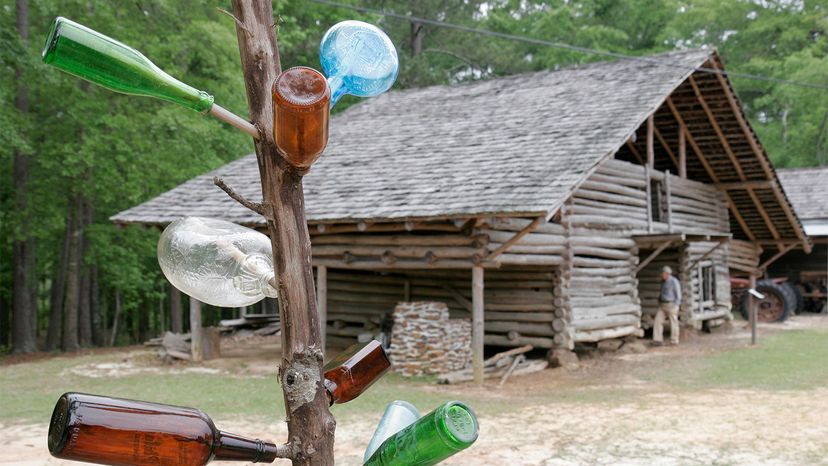Everybody’s got their favorite garden ornament. You might like a sundial or a statue of St. Francis of Assisi, or even a plastic pink flamingo. In the Southeastern United States, as well as in other parts of the country, the bottle tree is popular, but unlike your garden birdbath, the purpose of this ornament is to protect its owner from evil spirits.
A bottle tree can be made of a variety of different materials — posts with dowels driven into the sides, pieces of steel rebar welded together, or a real tree (in the Southeastern U.S., the tree traditionally used for this purpose is the crepe myrtle). The bottles are often made of blue glass, though you see bottle trees sporting glass of all colors and shapes. You can have a bottle tree in your garden just for its beauty, and, in that case, it truly doesn’t matter what type of vessel you attach to the ends of the tree’s limbs. However, according to lore, if you want to deal with an infestation of evil spirits, it’s best to get your hands on some blue glass bottles.
Where Did Bottle Trees Originate?
Bottle trees originated in the Congo in West Africa and date back to at least the ninth century. Some of the earliest European observations of vessels being hung in trees outside the home are from the mid-18th century, but bottle trees are likely much older than that. Very soon after European colonizers noticed the practice in Africa, bottle trees were also observed in the Caribbean in Black communities comprised of people brought there from West Africa via the trans-Atlantic slave trade. These early accounts described the purpose of bottle trees as being to ward off a variety of dangers that could befall the home, such as thieves, sterility, evil spells and bad spirits. If you hung bones and bottles in your mango tree, for instance, thieves wouldn’t touch the fruit.
From our partners:

Hoodoo and the Tradition of Bottle Trees
Of course, these ideas came from a larger set of spiritual practices that arrived in the Americas with enslaved people. Bottle trees are a practice in Hoodoo, a spiritual tradition that includes elements of Christianity, Islam and African spiritualism — not to be confused with Vodou, which is a religion rather than a set of spiritualist cultural practices.
The idea behind bottle trees in the Hoodoo tradition is that the world is full of marauding spirits, usually nocturnal, and usually up to no good. They can enter your house if you’re not careful, wreaking havoc — especially at night. However, these evil spirits are very interested in spangly glass bottles. If you hang them on trees outside your house, the spirits will enter the bottles to check them out, become trapped inside, and in the morning when the sun comes up, they will be destroyed in the bottle by the sunlight. If you’re not sure the light of day has really done its job, you can cork the bottle, take it to the river and throw it in the water. A bad spirit has no chance against the river because, according to Hoodoo, they absolutely hate water.
Bottle Trees Are Used to Honor the Dead
Bottle trees also have a special connection to the venerated dead. According to History Cambridge, which opened an installation of bottle trees in May 2022, called “Forgotten Souls of Tory Row: Remembering the Enslaved People of Brattle Street,” the tradition of bottle trees “was passed down through generations of enslaved and, later, free Black communities, marking the survival of a cultural practice despite the bonds of slavery. The distinctive blue bottles were placed on tree limbs to capture the energy, spirit and memories of ancestors.” Important and beloved relatives and community members were spoken of as great trees, and when they died, their tombs would be marked with large bottle trees, decked out with all sorts of vessels — bowls, cups, bottles, pots and pans — as well as knives, forks and bracelets.

The Hoodoo folk magic tradition of bottle trees was later adopted by Europeans on Southern plantations. Most often a crepe myrtle tree would be decked out with glass bottles of any color, but preferably blue, as blue is the color of water — which evil spirits hate! — and also heaven where the ancestors live.
You can make a bottle tree of your own or turn a tree in your yard into one. The bottle should be placed upside down with the mouth of the bottle facing the trunk. In addition to taking care of evil spirits, they’re also very attractive and make a beautiful addition to any garden space.
Source: HowStuffWorks
For enquiries, product placements, sponsorships, and collaborations, connect with us at hello@zedista.com. We'd love to hear from you!
Our humans need coffee too! Your support is highly appreciated, thank you!

